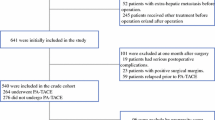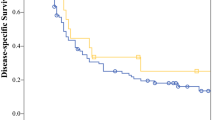Abstract
Background
The aim of this study was to evaluate the clinical value of adjuvant chemobiotherapy via portal vein for patients with hepatocellular carcinoma (HCC) with portal vein tumor thrombi (PVTT) following hepatectomy plus thrombectomy.
Methods
Eighty-six HCC patients with tumor thrombi in the portal trunk and/or the first-order branch were divided into groups A (n = 33) and B (n = 53). Patients in group A were treated with hepatectomy plus portal thrombectomy in combination with postoperative adjuvant chemobiotherapy administered via portal vein. The chemobiotherapy regimen consisted of 5-FU, adriamycin, cisplatin, and IFNα. Patients in Group B were subjected to hepatectomy plus thrombectomy alone. Survival rates of the two groups were compared and prognostic factors were identified using Cox proportional hazards model.
Results
Group A had a significantly longer median tumor-free survival time and median survival time compared with group B, i.e., 5.1 vs. 2.5 months (p = 0.017) and 11.5 vs. 6.2 months (p = 0.007), respectively. One-, two-, and three-year tumor-free survival rates were remarkably higher in group A than in group B, i.e., 18.4% vs. 8.4%, 13.8% vs. 4.2%, and 9.2% vs. 4.2%, respectively. One-, two-, and three-year survival rates were markedly greater in group A than in group B, i.e., 46.8% vs. 23.4%, 14.4% vs. 5.8%, and 9.6% vs. 5.8%, respectively. Multivariate analysis using the Cox proportional hazards model revealed that adjuvant chemobiotherapy, pathologic grading, and tumor size were independent prognostic factors for survival time (p = 0.000, 0.001, and 0.013, respectively), and chemobiotherapy and pathologic grading were independent prognostic factors for tumor-free survival time (p = 0.002 and 0.003, respectively).
Conclusions
Surgical resection combined with adjuvant chemobiotherapy via portal vein is an effective and safe treatment modality for hepatocellular carcinoma with major portal vein thrombus.


Similar content being viewed by others
References
Liver Cancer Study Group of Japan (1990) Primary liver cancer in Japan: clinicopathologic features and results of surgical treatment. Ann Surg 211:277–287
Llovet JM, Bru C, Bruix J (1999) Prognosis of hepatocellular carcinoma: The BCLC staging classification. Semin Liver Dis 19:329–338
Ikai I, Hatano E, Hasegawa S, et al. (2006) Prognostic index for patients with hepatocellular carcinoma combined with tumor thrombosis in the major portal vein. J Am Coll Surg 202:431–438
Niguma T, Mimura T, Tutui N (2005) Adjuvant arterial infusion chemotherapy after resection of hepatlcellular carcinoma with portal thrombosis: a pilot study. J Hepatobiliary Pancreat Surg 12:249–253
Pawlik TM, Poon RT, Abdalla EK, et al. (2005) Hepatectomy for hepatocellular carcinoma with major portal or hepatic vein invasion: results of a multicenter study. Surgery 137:403–410
Fan J, Zhou J, Wu ZQ, et al. (2005) Efficacy of different treatment strategies for hepatocellular carcinoma with portal vein tumor thrombosis. World J Gastroenterol 11:1215–1219
Fujioka N, Arivasu T, Arai N, et al. (2006) Role of p53 in the inhibitory effects of interferon-alpha subtypes on proliferation of hepatocellular carcinoma cells. Biomed Res 27:219–226
Oie S, Ono M, Yano H, et al. (2006) The up-regulation of type I interferon receptor gene plays a key role in hepatocellular carcinoma cells in the synergistic antiproliferative effect by 5-fluorouracil and interferon-alpha. Int J Oncol 29:1469–1478
Koike K, Takaki A, Tatsukawa M, et al. (2006) Combination of 5-FU and IFNalpha enhances IFN signaling pathway and caspase-8 activity, resulting in marked apoptosis in hepatoma cell lines. Int J Oncol 29:1253–1261
Leung TW, Tang AM, Zee B, et al. (2002) Factors predicting response and survival in 149 patients with unresectable hepatocellular carcinoma treated by combination cisplatin, interferon-alpha, doxorubicin and 5-fluorouracil chemotherapy. Cancer 94:421–427
Yin XY, Lu MD, Liang LJ, et al. (2005) Systemic chemo-immunotherapy for advanced-stage hepatocellular carcinoma. World J Gastroenterol 11:2526–2529
Leung TW, Patt YZ, Lau WY, et al. (1999) Complete pathological remission is possible with systemic combination chemotherapy for inoperable hepatocellular carcinoma. Clin Cancer Res 5:1676–1681
Edmonson HA, Steiner PE (1954) Primary carcinoma of the liver. a study of 100 cases among 48,900 necropsies. Cancer 7:462–503
Bruix J, Llovet JM (2002) Prognostic predictin and treatment strategy in hepatocellular carcinoma. Hepatology 35:519–524
Okada S, Okazaki N, Nose H, et al. (1992) Prognostic factors in patients with hepatocellular carcinoma receiving systemic chemotherapy. Hepatology 16:112–117
Raoul JL, Guyader D, Bretagne JE, et al. (1994) Randomized controlled trial for hepatocellular carcinoma with portal vein thrombosis: intra-arterial iodine-131-iodized oil versus medical support. J Nucl Med 35:1782–1787
Calvet X, Bruix J, Gines P, et al. (1990) Prognostic factors of hepatocellular carcinoma in the West: a multivariate analysis in 206 patients. Hepatology 12:753–760
Akashi Y, Koreeda C, Enomoto S, et al. (1991) Prognosis of unrectable hepatocellular carcinoma: an evaluation based on multivariate analysis of 90 cases. Hepatology 14:262–268
Yamaoka Y, Kumada K, Ino K, et al. (1992) Liver resection for HCC with direct remove of tumor thrombi in the main portal vein. World J Surg 16:1172–1176
Konishi M, Ryu M, Kinoshita T, et al. (2001) Surgical treatment of hepatocellular carcinoma with direct removal of the tumor thrombus in the main portal vein. Hepatogastroenterology 48:1421–1424
Zhou J, Tang ZY, Wu ZQ, et al. (2006) Factors influencing survival in hepatocellular carcinoma patients with macroscopic portal vein tumor thrombosis after surgery, with special reference to time dependency: a single-center experience of 381 cases. Hepatogastroenterology 53:275–280
Author information
Authors and Affiliations
Corresponding author
Rights and permissions
About this article
Cite this article
Liang, LJ., Hu, WJ., Yin, XY. et al. Adjuvant Intraportal Venous Chemotherapy for Patients with Hepatocellular Carcinoma and Portal Vein Tumor Thrombi Following Hepatectomy Plus Portal Thrombectomy. World J Surg 32, 627–631 (2008). https://doi.org/10.1007/s00268-007-9364-0
Published:
Issue Date:
DOI: https://doi.org/10.1007/s00268-007-9364-0




